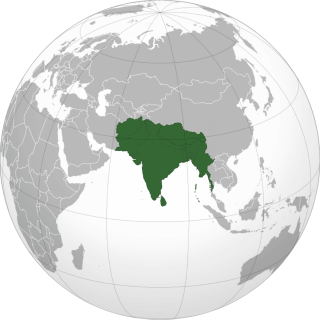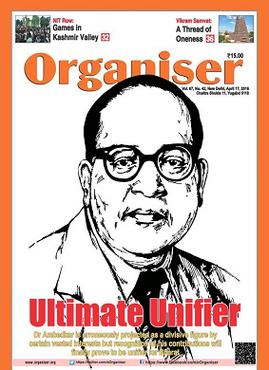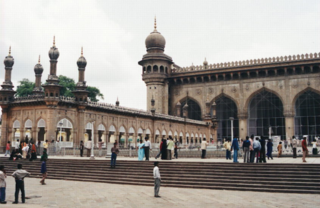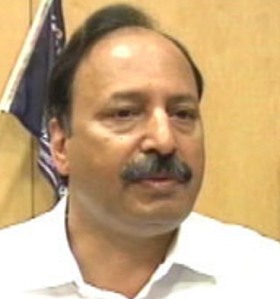
The Rashtriya Swayamsevak Sangh is a Hindu nationalist paramilitary volunteer organisation in India. The RSS is the progenitor and leader of a large body of organisations called the Sangh Parivar, which have presence in all facets of the Indian society, including the Bharatiya Janata Party, the ruling political party in India under Narendra Modi, the incumbent Indian prime minister. The present Sarsanghchalak of the RSS is Mohan Bhagwat.

The Bharatiya Jana Sangh was an Indian right wing political party that existed from 1951 to 1977 and was the political arm of Rashtriya Swayamsevak Sangh (RSS), a Hindu nationalist volunteer organisation. In 1977, it merged with several other left, centre and right parties opposed to the Indian National Congress and formed the Janata Party. In 1980, Jana Sangh faction broke away from Janata Party over the issue of dual membership, and formed the Bharatiya Janata Party.
The Sangh Parivar refers, as an umbrella term, to the collection of Hindu nationalist organisations spawned by the Rashtriya Swayamsevak Sangh (RSS), which remain affiliated to it. These include the political party Bharatiya Janata Party, religious organisation Vishva Hindu Parishad, students union Akhil Bharatiya Vidyarthi Parishad (ABVP), religious militant organisation Bajrang Dal that forms the youth wing of the Vishva Hindu Parishad (VHP), and the worker's union Bharatiya Kisan Sangh. It is also often taken to include allied organisations such as the Shiv Sena, which share the ideology of the RSS. The Sangh Parivar represents the Hindu nationalist movement of India. Members of the Sangh Parivar are informally referred to as Sanghis.

Keshav Baliram Hedgewar, also known by his moniker Doctorji, was an Indian physician and the founding Sarsanghachalak of the Rashtriya Swayamsevak Sangh (RSS). Hedgewar founded the RSS in Nagpur in 1925, based on the ideology of Hindutva with the intention of creating a Hindu Rashtra.

Akhand Bharat, also known as Akhand Hindustan, is a term for the concept of a unified Greater India. It posits that modern-day Afghanistan, Bangladesh, Bhutan, India, Maldives, Myanmar, Nepal, Pakistan and Sri Lanka is one nation.

Organiser is an affiliated publication of the right wing, Hindu organisation Rashtriya Swayamsevak Sangh (RSS), launched as a newspaper in 1947 in the weeks before the Partition of India. Despite its professed claims of independence, it is regarded by scholars as an official organ of the RSS. The newspaper has been edited by A. R. Nair, K. R. Malkani, L. K. Advani, V. P. Bhatia, Seshadri Chari and Dr R. Balashanker. The current editor is Prafulla Ketkar. Organiser was relaunched in a magazine format since the edition of 1 April 2014.
The 2006 Malegaon bombings took place on 8 September 2006 in Malegaon, a town in the Nashik district of the Indian state of Maharashtra, 290 km northeast of Mumbai. The Maharashtra Anti-Terrorism Squad (ATS) initially blamed the bombings on the Students Islamic Movement of India (SIMI), but in a chargesheet filed in 2013 the NIA and ATS joint investigation and involved evidences pointed towards involvement of an extremist group Abhinav Bharat in the said bombings. .
Walter K. Andersen is an American academic known for his studies of the Rashtriya Swayamsevak Sangh (RSS) – a Hindu nationalist organization. He currently serves as Senior Adjunct Professor of South Asia Studies at Johns Hopkins University Paul H. Nitze School of Advanced International Studies and is a part of the faculty of Tongji University, Shanghai (China). Previously, he taught comparative politics at the College of Wooster before joining the United States State Department as a political analyst for South Asia specializing in India and Indian Ocean affairs. Additionally, he was an adjunct professor at The American University in Washington, D.C.
The 2007 Samjhauta Express bombing was a terrorist attack that occurred around midnight on 18 February 2007 on the Samjhauta Express, a twice-weekly train service connecting Delhi, India, and Lahore, Pakistan. Bombs were set off in two carriages, both filled with passengers, just after the train passed Diwana near the Indian city of Panipat, 80 kilometres (50 mi) north of New Delhi. 70 people were killed in the ensuing fire and dozens more were injured. Of the 70 fatalities, most were Pakistani civilians. The victims also included some Indian civilians and three railway policemen.

The Rashtriya Sikh Sangat is an India-based Sikh affiliate of the Rashtriya Swayamsevak Sangh (RSS)

The Mecca Masjid blast occurred on 18 May 2007 inside the Mecca Masjid, a mosque located in the old city area of Hyderabad, capital of the Indian state of Telangana located very close to Charminar. The blast was caused by a cellphone-triggered pipe bomb placed near the Wuzukhana, a spot where ablutions are performed. Two more live IEDs were found and defused by the police. Sixteen people were reported dead in the immediate aftermath, of whom five were killed by the police firing after the incident while trying to quell the mob.

Sadhvi Nisha Rithambara is a Hindu nationalist ideologue and the founder-chairperson of Durga Vahini.
On 29 September 2008 three bombs exploded in the states of Gujarat and Maharashtra of India killing 10 people and injuring 80. Two bombs went off in Malegaon, Maharashtra, which killed nine people while another blast in Modasa, Gujarat resulted in the death of one person.
Abhinav Bharat is a Hindu organization founded by retired Indian Army Major Ramesh Upadhyay in 2006 in Pune, India. It has a large base in Madhya Pradesh. The organization is believed to be the revived form of the pre-Independence era Abhinav Bharat Society. The activities of the organisations received widespread attention after Maharashtra Anti Terrorist Squad (ATS) arrested its member for the 2006 Malegaon bombings case. It has no relationship to the Mumbai-based charitable trust of the same name.

Hemant Karkare AC was the chief of the Mumbai Anti-Terrorist Squad (ATS). He was killed in action during the 2008 Mumbai attacks. In 2009, he was posthumously given the Ashoka Chakra, India's highest peacetime gallantry decoration.

The Muslim Rashtriya Manch is a Muslim organisation in India, inspired by the Hindu nationalist Rashtriya Swayamsevak Sangh (RSS). It was formed in 2002 in the presence of the then RSS chief K.S. Sudarshan to grow dialogue with Muslim community.
Swami Aseemanand is an Indian Hindu renunciate and Hindu nationalist activist who was accused of masterminding the Ajmer Dargah bombing, Mecca Masjid blast, and the 2007 Samjhauta Express bombings— before being acquitted of all charges.

The Ajmer Dargah bombing occurred on 11 October 2007, in the courtyard of Sufi maulana Moinuddin Chishti in Ajmer, Rajasthan, India, after the Iftar period had started. On 22 March 2017 a Special NIA Court convicted three Rashtriya Swayamsevak Sangh pracharaks Devendra Gupta, Bhavesh Patel and Sunil Joshi. Sunil Joshi and Devendra Gupta were found guilty on charges of conspiracy and Bhavesh Bhai Patel was found guilty of planting the explosive on the blast site. Gupta and Patel were awarded life imprisonment. Sunil Joshi had been found shot dead in mysterious circumstances soon after the blast in Dewas, Madhya Pradesh.

The Bhagwa Dhwaj, also called Kesariya flag, is a saffron-colour flag, that served as the flag of the Maratha Empire. "It is swallow-tailed and of a deep saffron color emblematic of the followers of God Mahādeva." It was adopted by V.D. Savarkar's Akhil Bharat Hindu Mahasabha in 1915 and later by the Rashtriya Swayamsevak Sangh. It is now associated with Hindutva. Double pennant, triangle, or pennant – shaped saffron coloured flags with a tassels at its end is also used by Hindus as Bhagwa Dhwaj. Sometimes it also uses Hindu religious symbols like the Om letter or a Hindu Swastika at its center. Saffron is considered a sacred and holy colour in Hinduism. RSS sees it as a symbol of victory and strength. In medieval times, after the decline of Islamic rule in India and the emergence of the Maratha Empire there was a rise of Hindu nationalism and at that time the saffron flag was adopted by Shivaji.
Pragya Singh Thakur, better known as SadhviPragya, is an Indian politician and Member of Parliament representing Bhopal and belonging to the Bharatiya Janata Party. During her college days, she was an active member of Akhil Bharatiya Vidyarthi Parishad (ABVP) and later joined various affiliate organisations of the Rashtriya Swayamsevak Sangh (RSS).











